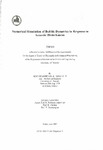| dc.description.abstract | The dynamic behavior and the fashion of collapse of a free bubble play a
significant role in the phenomenon of single cavitation bubble luminescence (SCBL)
and single bubble sono-luminescence (SBSL), in which light is emitted during its
breakdown. In SCBL, the bubble is produced by the application of a laser pulse, in the
host liquid, with a duration of 10'15 sec (femtosecond bubbles) and 10'9 sec (nanosecond
bubbles). The resulting bubbles have size of the order of 5 and 500 pm, respectively.
The femtosecond bubbles display severe elongation with regards to the axis of
symmetry, while light is not emitted during their collapse. In contrast, the nanosecond
bubbles exhibit almost spherosymmetric shape initially and collapse producing light. A
parametric study is conducted on the fashion of collapse of bubbles, of various sizes, for
weak or strong elongation and vanishing small or large internal overpressure,
considering axisymmetric oscillations with weak viscous effects. Further, an effort is
made to reproduce, as close as possible, respective SCBL and SBSL experiments,
aiming to investigate the effect of the initial asymmetry on the fashion of collapse and
the velocity of the resulting jet during collapse.
Recently, a significant number of applications in diagnostic and therapeutic
medicine use the ability of microbubbles, encapsulated by an elastic membrane (contrast
agents), to reflect the ultrasound waves. Initially, a model that predicts the backscatter
signal of the microbubble as a function of the membrane properties, of the host liquid
and the width and the frequency of the acoustic disturbances, is presented. This model
predicts with accuracy the effect of the non linear membrane constitutive law on the
microbubble response for large acoustic disturbances in comparison to experimental
measurements.
The control of cohesion of microbubbles is desirable in several applications,
such as in quantitative evaluation of heart blood flow (contrast perfusion imaging). In
order to gain understanding regarding its cohesion range, the large-amplitude
axisymmetric oscillation and collapse of an encapsulated mibrobubble is examined. The
shear stresses that develop on the membrane due to the bending moments are accounted
for, based on the shell stability theory, and are determined by the scalar bending
modulus. This is a measure of the shell resistance to bending and is introduced as an
additional parameter, due to the anisotropy of the membrane elasticity along the
interface and perpendicular to it. With the help of stability analysis, it is feasible to
estimate the range of the parameters for shape oscillations of the microbubble, as well
as for the buckling of the shell. In combination with the model of the spherosymmetric
oscillations, a theoretical tool is developed for the characterisation of a microbubble
with regards to its membrane elasticity, bending resistance and viscosity. Phase
diagrams are constructed where the regions of stable or unstable oscillation of a
microbubble are defined. Finally, axisymmetric simulations of the interaction of the
external flow field and the encapsulated microbubble are performed, implementing a
hybrid boundary-finite element method, in order to determine the conditions under
which a jet is created during the oscillation of the microbubble; a phenomenon which is
observed when a microbubble oscillates near the walls of neighbouring tissues. | en |



